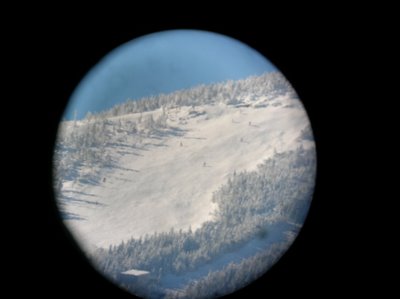
Here's a sample digiscoping pic from the New Years house. Can pic out the skiers that are a few miles away. The atmospheric distortion over several miles really limited the resolution. Taken with (our former non-waterproof) Nikon Coolpix 4600 and the 90 mm Mak -cassegrain scope that I had up there. 1/193s, f/4.9, ISO 50.
Apparently there is some skill needed to do this for birding, as you have to be quite quick. If you use a spotting scope, the tripod is necessary I imagine? The image must be jumping all over the place. I wish there was a way to attach the camera to one of the binoc lenses.
ReplyDeleteBill,
ReplyDeleteHow do you connect the camera to the scope? Carrie and I are looking at microscopes and want to connect a digital camera to it. We have found some basic adaptors but the better option seems to be a intermediate lens assembly that...well have a look http://www.microscope-depot.com/digadapt.asp?DCID=116
I would love some other options. And any thoughts about where to purchase a good (yet relatively inexpensive) microscope?
Kevin
Chris - we have a 300 mm telephoto lens that along with our SLR yields ~ 9-10x magnification - about the same as you'd get with the binocs, much easier. Cheap lense, only cost like 200.00. Also, can directly attach the SLR to the scope, the scope acts like a 1250 mm lens, which is ~ 35x with the dSLR. Personally, I find taking pics of birds to be a P.I.T.A. even with just 5x magnification, still need a tripod to steady the image enough, or use really fast film/sensor, which makes for crappy images too... so... can't win. I determined I'd need to spend 5 grand to get a setup that would make me happy for bird photography. Except for ducks and geese and such... they're easy. We have lots of pics of ducks and geese and such.
ReplyDeleteHey Kev - In this case, I just held the camera up to the eyepiece. It was a low power telescope eyepiece and had quite a bit of eye relief, so it worked fairly well. For higher power eyepieces or microscope eyepieces, the exit and eye relief is likely too small to just do this, but you could easily use a tripod for the camera, or MacGyver some sort of clamp to hold the camera the appropriate distance from the eyepiece.
There really are a ton of options for imaging from a microscope. A very common way is to mount a digicam/webcam to an eyepiece with any one of a hundred different adapters/clamps/. A tripod holding the camera over the eyepiece should probably work fine.
A higher quality and perhaps more flexible option would be to get a trinocular microscope with decent optics that is directly capable of mounting an SLR via a t-mount and t-ring adapter. T-rings only cost ~ 15.00 and are camera mount specific. Some scopes have t-mount threads attached and come with the necessary photo optics, some don't. Some can take expensive scope specific t-mount adapters. Trinocular microscopes usually will have a prism in the tube to divert the light towards the oculars, camera, or both. Going the trinocular route and getting a t-mount and t-ring for an SLR is probably the easiest option, that will yield the best results, IMHO.
I'm gonna get a t-ring to mount my camera directly to my telescope ( which is already threaded to accept it...) for the WSB. No eyepiece necessary.
Are you looking for a compound scope or a stereo scope? Either way, a very basic scope with halfway decent optics - ie like the "student scopes" used in the botany labs, etc at ESF will probably cost quite a bit, > $1000.00. A good bet might be ebay. saw some decent-looking but pretty basic scopes there but with brand names I've never heard of for <$500.00. Depending upon the magnification that you want, if you want to take serious high-res/sharp/contrasty images from a microscope, I'd expect it can be possibly be done for a few grand with used equipment and a little elbow grease. I am spolied though. The telescope we are acquiring for our lab is a stereoscope which is going to primarily be used for documenting various plant structures. Is fairly basic, but high quality zoom capable stereoscope that costs ~ $10k without any of the extra bells and whistles, camera and adapters also excluded. With the bells and whistles we are getting, it will be ~ $20,000. Compound scope was much more than that.
Check this out - It's the QX5 usb microscope. Intended as a toy. Came across the page when researching how I might be able to build a cheaposcope.
http://www.microscopy-uk.org.uk/mag/indexmag.html?http://www.microscopy-uk.org.uk/mag/artdec04/dwqx5.html
Available at thinkgeek for 80 bucks.
http://www.thinkgeek.com/gadgets/electronic/77aa/